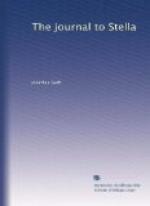In 1712 occasional letters took the place of the daily journal to “MD,” but there is no change in the affectionate style in which Swift wrote. In the spring he had a long illness, which affected him, indeed, throughout the year. Other reasons which he gives for the falling off in his correspondence are his numerous business engagements, and the hope of being able to send some good news of an appointment for himself. There is only one letter to Stella between July 19 and September 15, and Dr. Birkbeck Hill argues that the poem “Cadenus and Vanessa” was composed at that time.[6] If this be so, it must have been altered next year, because it was not until 1713 that Swift was made a Dean. Writing on April 19, 1726, Swift said that the poem “was written at Windsor near fourteen years ago, and dated: it was a task performed on a frolic among some ladies, and she it was addressed to died some time ago in Dublin, and on her death the copy shewn by her executor.” Several copies were in circulation, and he was indifferent what was done with it; it was “only a cavalier business,” and if those who would not give allowances were malicious, it was only what he had long expected.
From this letter it would appear that this remarkable poem was written in the summer of 1712; whereas the title-page of the pamphlet says it was “written at Windsor, 1713.” Swift visited Windsor in both years, but he had more leisure in 1712, and we know that Vanessa was also at Windsor in that year. In that year, too, he was forty-four, the age mentioned in the poem. Neither Swift nor Vanessa forgot this intercourse: years afterwards Swift wrote to her, “Go over the scenes of Windsor. . . . Cad thinks often of these”; and again, “Remember the indisposition at Windsor.” We know that this poem was revised in 1719, when in all probability Swift added the lines to which most exception can be taken. Cadenus was to be Vanessa’s instructor:—
“His conduct might
have made him styled
A father, and
the nymph his child.”
He had “grown old in politics and wit,” and “in every scene had kept his heart,” so that he now “understood not what was love.” But he had written much, and Vanessa admired his wit. Cadenus found that her thoughts wandered—
“Though she seemed
to listen more
To all he spoke
than e’er before.”
When she confessed her love, he was filled with “shame, disappointment, guilt, surprise.” He had aimed only at cultivating the mind, and had hardly known whether she was young or old. But he was flattered, and though he could not give her love, he offered her friendship, “with gratitude, respect, esteem.” Vanessa took him at his word, and said she would now be tutor, though he was not apt to learn:—




